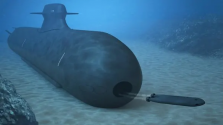Sub-based land attacks are too expensive and as you said achieving large salvos is impossible. But I think China will need sub-based cruise missile capability because of active sonar performance. If they are really getting that good, an only-torpedo submarine may become an escort ship hunter rather than a carrier hunter. If you have that capability land-attack capability is just a modification. It may have some uses like bombing the US bases in CONUS. Other than that pretty useless indeed. Cruise missiles in general are very good for surprise attacks that can cripple a small military in a short time. Combining them with subs improves that. And I think that's why the US liked it.-----
As BoraTas argued a few pages back, the practice of putting a lot of cruise missile (and even more egregiously special forces) on US subs originate from the submarine service's plea for continued relevance post Cold War, when its original missions disappeared. It is the undersea equivalent of the Zumwalt's main guns (i.e. overpriced capability that can be better performed via aircrafts).
I should also note the original Tomahawk and the P-700/800 in the Cold War era were nuclear tipped and had a very different cost calculus to conventional weapons. Nuclear tipped SSG could make a lot of sense for North Korea, Pakistan or Israel.
Very debatable. China will not have an opportunity to make such a first strike unless it becomes the aggressor against Japan or the USA. If they decide to intervene they will prepare for Chinese missile strikes. Pre-positioned subs cannot achieve anything extra after that point. Cruise missiles do not get detected until they are very close to their target because of their flight altitude. And modern air defense systems provide 360 degree coverage as standard. I don't see any advantage here again.If those submarine launched missiles were launched in isolation, yes.
However, they would be part of a comprehensive first strike alongside long range land based strike systems (IRBMs, HGVs, bombers with stand off missiles), naval surface strike systems (carrier based strike and surface combatants with LACMs/AShBMs/HGVs).
Not to mention they would have EW/ECM support.
I disagree, I believe that the major reason why submarine launched weapons can be complementary to land based and naval surface strike systems, is because submarine launched weapons can be deployed much closer to the target in a manner that the enemy cannot easily detect, and in turn enable multi-axis and multi-distance first wave strikes in conjunction with land and naval surface strike systems.
The inability to be immediately replenished is fine, because their land attack or anti-surface warload would be intended for contributing to a first wave strike before retreating and conducting undersea warfare missions. They would not be expected to carry out an entire strike campaign by themselves, heck they wouldn't even be expected to carry out an entire first wave strike by themselves, perhaps only 25% of the first wave at most, if not less. However, by being able to be launched closer to the enemy and in other directions outside of the major axis of attack, it can augment the effectiveness of the overall first wave strike mission.
I disagree with BoraTas argument, and I think the utility of a large warload of submarine launched long range land attack/anti ship weapons deployed from acoustically stealthy and technologically competitive nuclear submarines cannot be understated, when viewed in context of an overall air-naval-missile campaign.
(In terms of using SSNs as special forces insertion, I do agree that it is a much more niche capability and relatively unimportant)
Combining sub operations with other assets is hard too. Another trend that was working against subs in the last 30 years was networking. Subs couldn't benefit much from it because they can hardly communicate. Subs are still lone wolves in 2022.
Where the sub based land attack capability shines is strikes in distant regions where your airpower can not reach.
For China, these would be 50 US states and the Panama canal.
As I said, I think the 09V needs a lot of VLS but for anti-ship missions foremost.

